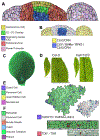WOX going on: CLE peptides in plant development
- PMID: 34077886
- PMCID: PMC8545713
- DOI: 10.1016/j.pbi.2021.102056
WOX going on: CLE peptides in plant development
Abstract
The development of plant tissues requires cell-cell communication facilitated by chemical and peptide hormones, including small signaling peptides in the CLAVATA3/EMBRYO-SURROUNDING REGION (CLE) family. The paradigmatic CLE signaling peptide CLAVATA3 regulates the size of the shoot apical meristem and the expression of the stem cell-promoting WUSCHEL transcription factor through an unknown mechanism. This review discusses recent advances in CLE signaling, showing that CLE pathways are conserved in bryophytes, that CLE peptides in Arabidopsis thaliana regulate stem cell identity and cell division in root tissues, and connections to auxin biosynthesis in regulating flower and leaf development. These advances shed light on potential WUSCHEL family-independent aspects of CLE signaling and the overlap between CLE and auxin signaling.
Keywords: Auxin; CLAVATA; CLE peptide; Meristem; Plant development; Receptor kinase; WOX.
Copyright © 2021 Elsevier Ltd. All rights reserved.
Conflict of interest statement
Declaration of competing interest The authors declare that they have no known competing financial interests or personal relationships that could have appeared to influence the work reported in this paper.
Figures


Similar articles
-
The rise of CLAVATA: evidence for CLAVATA3 and WOX signaling in the fern gametophyte.Plant J. 2025 Jan;121(2):e17207. doi: 10.1111/tpj.17207. Epub 2024 Dec 14. Plant J. 2025. PMID: 39673734 Free PMC article.
-
CLE peptides: critical regulators for stem cell maintenance in plants.Planta. 2021 Nov 29;255(1):5. doi: 10.1007/s00425-021-03791-1. Planta. 2021. PMID: 34841457 Review.
-
CLE signaling systems during plant development and nematode infection.Plant Cell Physiol. 2012 Dec;53(12):1989-99. doi: 10.1093/pcp/pcs136. Epub 2012 Oct 8. Plant Cell Physiol. 2012. PMID: 23045524 Review.
-
A CLE-WOX signalling module regulates root meristem maintenance and vascular tissue development in rice.J Exp Bot. 2013 Dec;64(17):5359-69. doi: 10.1093/jxb/ert301. Epub 2013 Sep 16. J Exp Bot. 2013. PMID: 24043854
-
Functional analysis of the cotton CLE polypeptide signaling gene family in plant growth and development.Sci Rep. 2021 Mar 3;11(1):5060. doi: 10.1038/s41598-021-84312-8. Sci Rep. 2021. PMID: 33658526 Free PMC article.
Cited by
-
Research Progress of Small Plant Peptides on the Regulation of Plant Growth, Development, and Abiotic Stress.Int J Mol Sci. 2024 Apr 8;25(7):4114. doi: 10.3390/ijms25074114. Int J Mol Sci. 2024. PMID: 38612923 Free PMC article. Review.
-
MtCLE08, MtCLE16, and MtCLE18 Transcription Patterns and Their Possible Functions in the Embryogenic Calli of Medicago truncatula.Plants (Basel). 2023 Jan 17;12(3):435. doi: 10.3390/plants12030435. Plants (Basel). 2023. PMID: 36771520 Free PMC article.
-
A major role of class III HD-ZIPs in promoting sugar beet cyst nematode parasitism in Arabidopsis.PLoS Pathog. 2024 Nov 7;20(11):e1012610. doi: 10.1371/journal.ppat.1012610. eCollection 2024 Nov. PLoS Pathog. 2024. PMID: 39509386 Free PMC article.
-
Structure and functional divergence of PIP peptide family revealed by functional studies on PIP1 and PIP2 in Arabidopsis thaliana.Front Plant Sci. 2023 Nov 24;14:1208549. doi: 10.3389/fpls.2023.1208549. eCollection 2023. Front Plant Sci. 2023. PMID: 38078092 Free PMC article.
-
A space for time. Exploring temporal regulation of plant development across spatial scales.Plant J. 2025 Apr;122(1):e70130. doi: 10.1111/tpj.70130. Plant J. 2025. PMID: 40163327 Free PMC article. Review.
References
-
- Fletcher JC (2020). Recent advances in Arabidopsis CLE peptide signaling. Trends in plant science. - PubMed
-
- Zhang H, Han Z, Song W, and Chai J (2016). Structural Insight into Recognition of Plant Peptide Hormones by Receptors. Molecular Plant 9, 1454–1463. - PubMed
-
- Shinohara H, and Matsubayashi Y (2015). Reevaluation of the CLV3-receptor interaction in the shoot apical meristem: dissection of the CLV3 signaling pathway from a direct ligand-binding point of view. The Plant Journal 82, 328–336. - PubMed
-
- Ohyama K, Shinohara H, Ogawa-Ohnishi M, Matsubayashi Y, A glycopeptide regulating stem cell fate in Arabidopsis thaliana. Nature chemical biology 5, 578–580 (2009). - PubMed
Publication types
MeSH terms
Substances
Grants and funding
LinkOut - more resources
Full Text Sources

